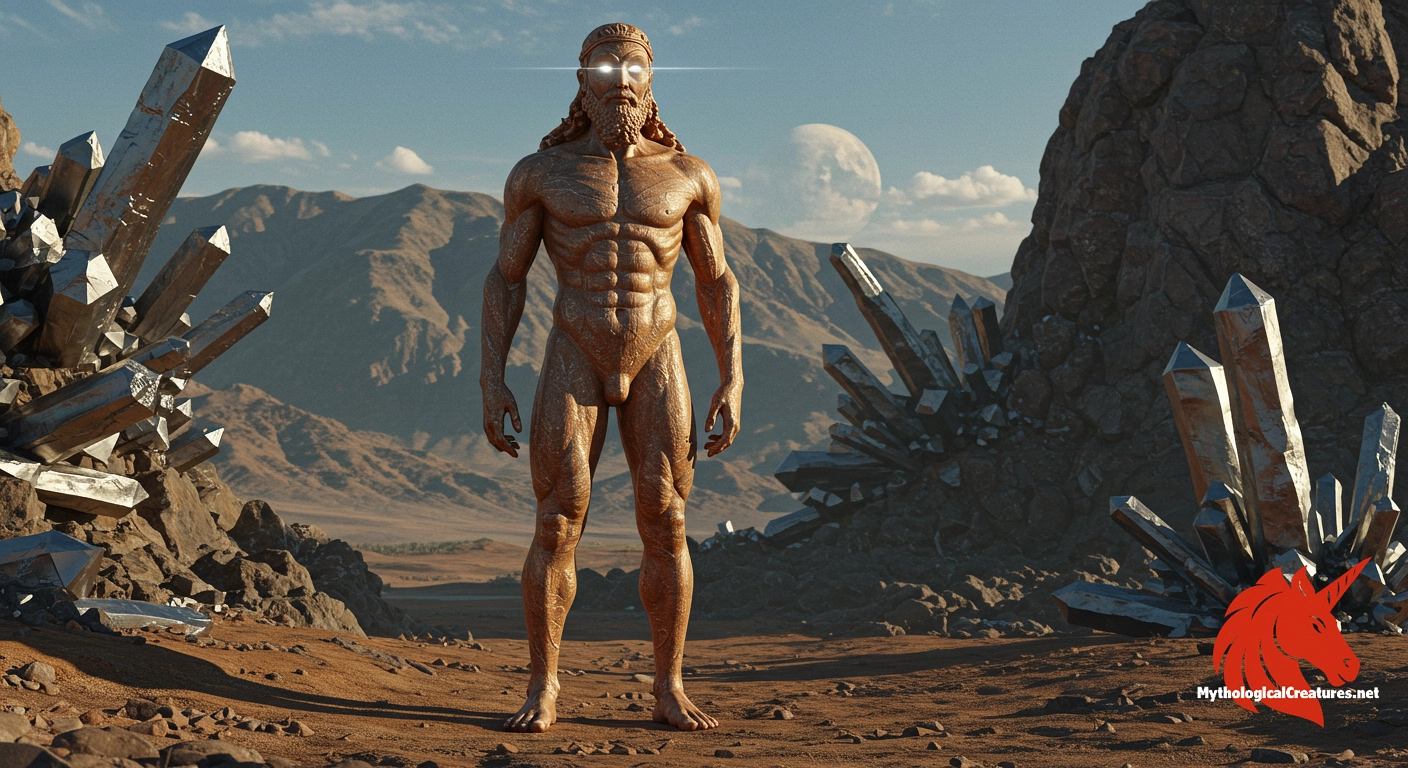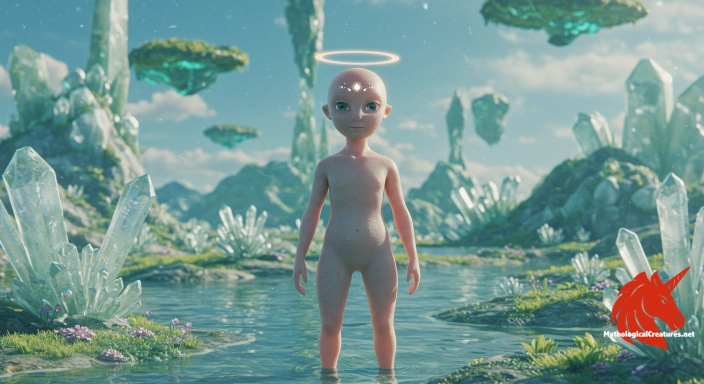Kshatra Vairya: Kshatra Vairya is one of the great seven bounteous immortals of Ahura Mazda in Zoroastrianism.

Kshatra Vairya
Kshatra Vairya - He symbolises the evolution of the cosmos from a stony creation to a metallic, crystalline order, thereby underscoring the divine principle of good thoughts and cosmic balance.
Origins & First Encounters
Kshatra Vairya emerges as one of the central divine figures in the Zoroastrian cosmology, revered as one of the seven bounteous immortals who serve the Creator Ahura Mazda. His very name, with its Avestan and Sanskrit roots, encapsulates the idea of dominion and authority over the material and spiritual worlds. Birthed from the divine principle Vohu Manah, he embodies the essential quality of Good Thoughts, establishing a firm connection between ethical guidance and cosmic creation. Early liturgical texts subtly introduce his presence, reflecting a period when the cosmos was first understood in relation to elemental forces. Across these ancient writings, his representation evolves from that of a stony, steadfast firmament to one rich with the symbolism of metal, mirroring the human progression from the Stone Age to the era of metallurgical mastery. The mythic narrative surrounding Kshatra Vairya illustrates how religious belief and natural phenomena conjointly shape the identity of deities. His role not only underscores the sanctity of order but also celebrates the transformative power inherent in the elements. Over time, his attributes have been refined and elaborated upon by successive generations, making him a dynamic symbol of both continuity and change. In ritual and tradition, he is celebrated as an enduring embodiment of cosmic order and divine oversight.
Source Texts & Tale Variants
Ancient Avestan texts first mention Kshatra Vairya in a context that leaves much to interpretation, with early hymns offering only oblique references to his essence. The Gathas, though primarily poetic and symbolic, provide the earliest foundation for his myth without anchoring him to a specific creation narrative. As time advanced, later texts and commentaries began to imbue him with additional responsibilities, particularly as the guardian of metals, which signalled a shift in cultural priorities. Middle Persian and Pahlavi sources continue this trend, drawing on allegorical language to deepen his association with both material substances and divine rulership. Multiple versions of his story illustrate how his character was adapted to suit new social and technological realities, such as the advent of bronze and iron. Oral traditions further enriched his narrative, allowing regional communities to reinterpret his myth to reflect local cosmological understandings. These variant accounts, though differing in nuance, invariably reaffirm his status as an immortal custodian of order and physical substance. The multiplicity of sources highlights a vibrant tradition of reinterpretation and adaptation that has spanned centuries. Each strand of tradition, while emphasising different aspects of his reign, contributes to a composite portrait that resonates with both ancient ritual and evolving societal values.
Form & Powers
In artistic depictions, Kshatra Vairya is envisioned with an ethereal form that melds the enduring solidity of stone with the luminous quality of refined metal. His countenance is rendered with an almost imperceptible gleam, suggesting that divine power is as much about inner radiance as it is about physical manifestation. Traditional imagery often portrays him adorned with intricate ornamental details, evoking the textures of hammered bronze and polished iron. His physique is both robust and graceful, merging the formidable strength of raw ore with the elegance of celestial design. Many depictions highlight a radiant halo or aureole that encircles his head, symbolising an eternal connection to the cosmic sky. His eyes and features are contemplated as gateways to an understanding of the universe, offering glimpses of both ancient tradition and timeless mystery. Some visual interpretations illustrate subtle gradations in his form, hinting at the historical transition from a stony firmament to a brilliant, metallic expanse. The overall visual aesthetic of Kshatra Vairya thus captures a harmonious balance between material endurance and ethereal light, making his imagery a potent symbol of transformation and authority.
Regional Faces
Regional interpretations of Kshatra Vairya reveal a tapestry of cultural adaptations that span the breadth of ancient Persia and its neighbouring lands. In mainland Iran, he is frequently known as Shahrivar, a name that not only honours his divine aspect but also lends its identity to a significant month in the local calendar. Local traditions amplify his connection with metal, integrating motifs from artisanal crafts and forging practices that have deep historical roots in the region. In certain rural communities, the deity is celebrated as a symbol of natural order and craftsmanship, his myth interwoven with the landscape and daily life. Urban centres, by contrast, often present a more cosmopolitan depiction, blending ancient iconography with modern interpretations of material transformation. Some areas retain the older imagery of a stony sky, while others have embraced the later vision of a crystalline, metallic firmament. Diaspora groups have also embraced his legacy, adapting his symbols to articulate contemporary struggles and aspirations while honouring ancestral heritage. This regional diversity not only reinforces the versatility of Kshatra Vairya’s myth but also illustrates how local customs and beliefs continually reshape and sustain ancient traditions. Across these various interpretations, his figure remains a bridge between the transcendent world of the divine and the tangible realm of human endeavour.
Cultural Parallels
The symbolic attributes of Kshatra Vairya invite comparisons with analogous figures in other ancient mythologies, thereby highlighting a shared human fascination with the interplay of matter and divinity. In Vedic traditions, for example, the linguistic and conceptual echoes of the term ‘kṣatra’ resonate with notions of authority and martial power, underscoring the link between divine rule and earthly order. There exist thematic parallels in Greek mythology, where deities embody cosmic stability and the transformative nature of elemental substances. In the Roman context, myths emphasise a transition from raw, unrefined materials to those that are forged and perfected, much like the evolution of Kshatra Vairya’s symbolism. Medieval alchemical traditions in Europe further mirror this duality by allegorising the process of transmutation as a journey towards spiritual and material purity. Celtic lore, too, features guardians whose protective roles and elemental attributes evoke a similar balance between nature and divine intervention. The recurring motif of a protective overseer who bridges the elemental with the metaphysical is a common thread across these diverse cultural narratives. Such cross-cultural comparisons illuminate how ancient societies used myth to articulate their understanding of nature’s inherent order. In this way, Kshatra Vairya stands as a unique yet universally resonant symbol, bridging disparate mythological traditions through shared themes of transformation and dominion.
Legacy & Modern Evolution
The historical evolution of Kshatra Vairya is emblematic of the dynamic interplay between social change and religious symbolism over the millennia. Initially, he was conceptualised as a divine representation of the cosmos in its most rudimentary, stony form, reflecting a time when humanity’s understanding of the natural world was in its infancy. With the progression into the Bronze and Iron Ages, his attributes were gradually reinterpreted to align with the emerging metallurgical advancements and the celebration of human ingenuity. This transformation allowed him to become a potent symbol of not only divine order but also the transformative power of technology and craft. Contemporary Zoroastrian communities continue to venerate his image during religious observances, celebrating his timeless presence through ritual and cultural festivities. Modern artistic endeavours reimagine his form through various media, underscoring his relevance in the dialogue between tradition and modernity. Intellectual and cultural discourses frequently invoke his myth as a metaphor for the enduring resilience of ancient wisdom in the face of modern challenges. His legacy is further cemented by his influence on local calendars, literature, and even contemporary interpretations of environmental stewardship. Through each historical phase, Kshatra Vairya remains an indelible symbol of transformation, authority, and the perpetual quest to harmonise the material with the divine.
Interesting Fact
It is noteworthy that the Persian month Shahrivar is named after him, underlining the lasting impact of his myth on both religious tradition and cultural identity.
Quick Creature Info
Origin:
Features:
Associations:
Our Mythic Legendary Rating:

Also Sometimes Known As:
Habitat:
Supernatural Powers:
Physical Attributes:
Abilities:
Behavior:
Lore:
Related Creatures, Tales or Lore
- VVohu Manah
- AAsha Vahishta
- SSpenta Armaiti
References
Discover Another Mythical Legend You May Not Have Heard Of?
Uncover the mysteries of ancient folklore and expand your knowledge of legendary beings from cultures around the world.
Dare to Meet the Simat Hayyi....
Mythical Disclaimer: The images and data on this site are derived from various historical and literary sources, but we have found that many myths often have multiple versions and interpretations across references, sometimes contradictory. As a result, these creature depictions are artistic interpretations—imaginative blends of folklore, legend, and a dash of AI guesswork. Because creature descriptions vary widely, our illustrations and accompanying information represent our best effort to honor mythology while bridging creative gaps. Enjoy these interpretations—just remember, we've done our best to respect the stories and validate available data, but in the realm of mythology, details often shift, imagination leads the way, and nothing is ever set in stone!
Curated by the Mythological Creatures Team (rev. May 2025)
